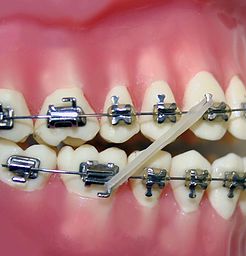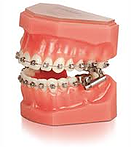 Arch Wires
Arch Wires
The main wires or arch wires are shaped specifically to fit around the arch into bracket slots. Teeth move from the pressure that is applied by the braces. That pressure comes from the arch wire, which guides the direction of movement. Note that the arch wires are held in place by a series of small rubber rings that tie the arch wire into the bracket. ANY ADDITIONAL BENDS CAUSED BY LACK OF CARE IN EATING MAY MAKE THE TEETH MOVE WRONGLY.
 Bands
Bands
Bands are a ring of metal that fit around the back teeth (molars and sometimes pre-molars). Each tooth has its own shape and size. The bands are selected from a range of sizes. The aim is to select the tightest fitting band. The bands are sealed in position using dental cement (like glue) containing fluoride to prevent any decalcification during treatment.
 Brackets
Brackets
This is the handle we use to move teeth. There is a bracket on each tooth. The arch wire fits tightly in a slot in the bracket. Brackets may be attached directly to each tooth or to a band.
 Coil Spring
Coil Spring
This spring fits between brackets and over the arch wire. It can be used to make space between teeth.
 Elastics (rubber bands)
Elastics (rubber bands)
A small rubber band that is hooked between different points. Rubber bands apply pressure to the upper and lower teeth so that they move into the correct positions. They also help to correct overbites, underbites and crossbites.
They are typically worn at all times, even while sleeping. Patients generally remove rubber bands to brush and floss and also to eat, but it is not required. Rubber bands should be worn as instructed. Failure to do so may delay progress or negatively affect treatment results.
 Herbst
Herbst
The Herbst appliance is fixed to your molars on the upper and lower jaws with bands that are cemented into place. It is used to correct an overbite.
 Separators
Separators
Small rubber rings used to create space between teeth before the bands are cemented in place.

